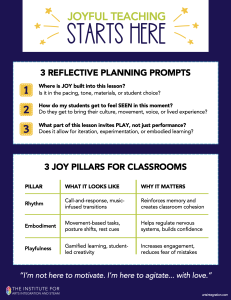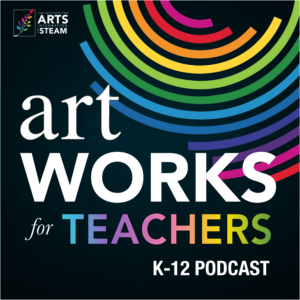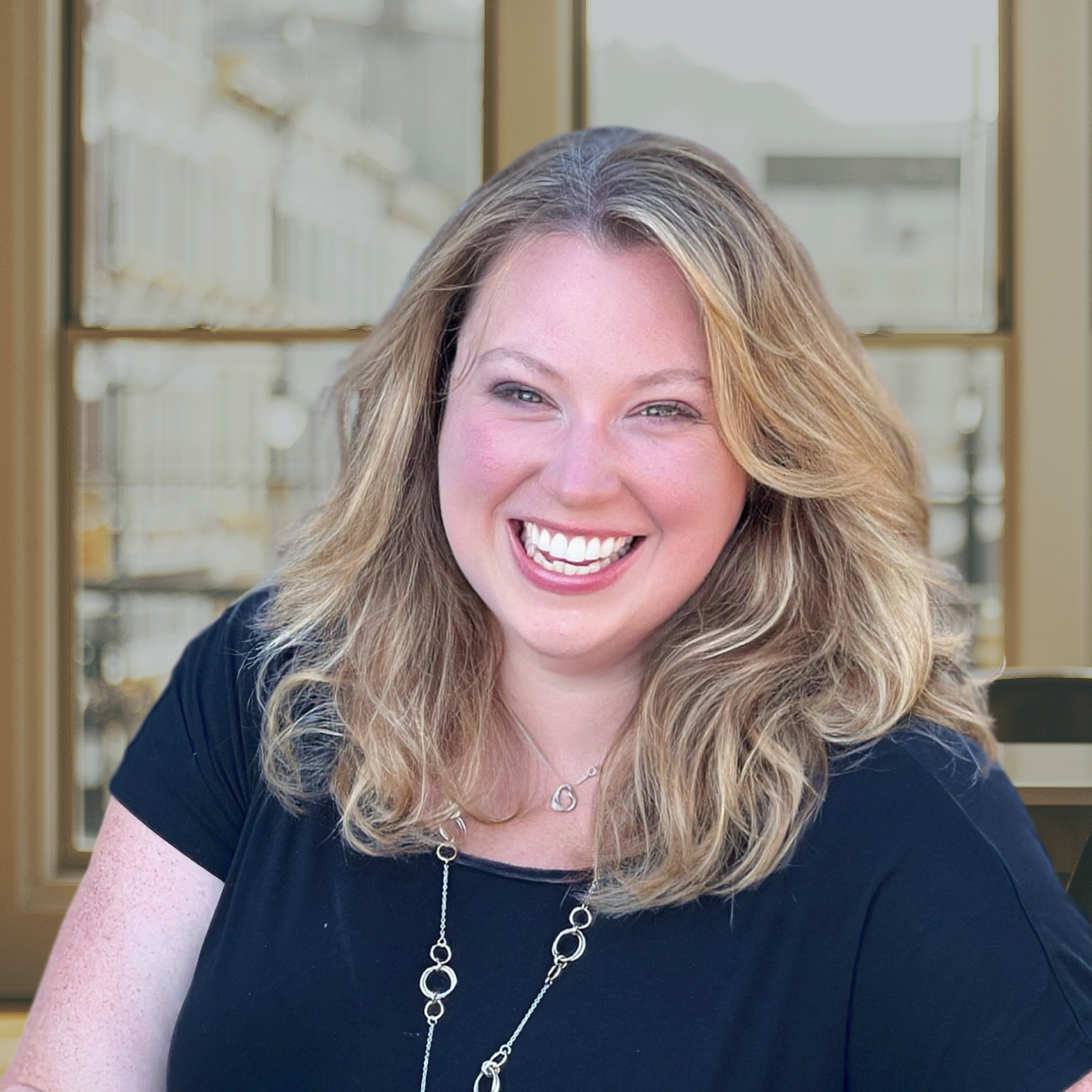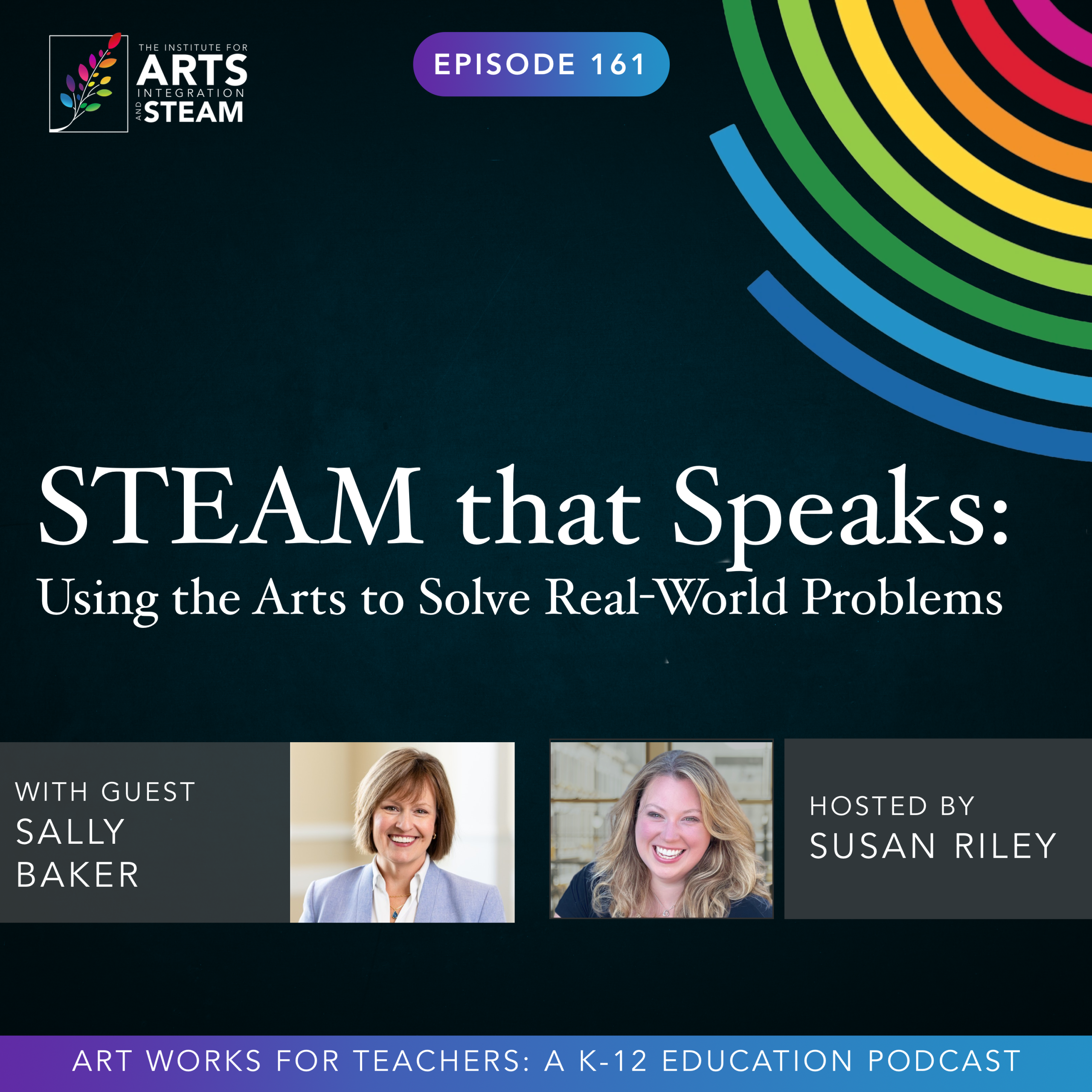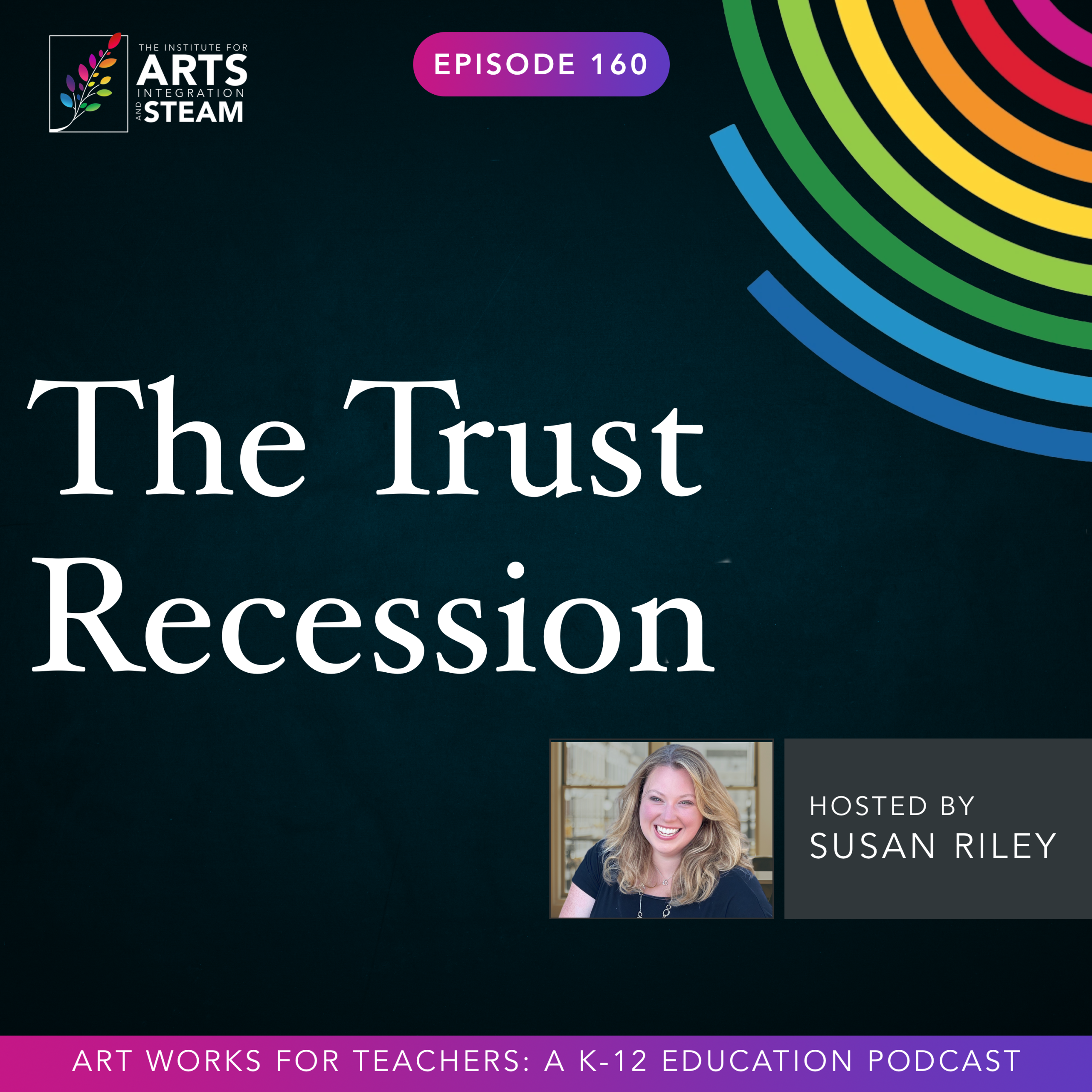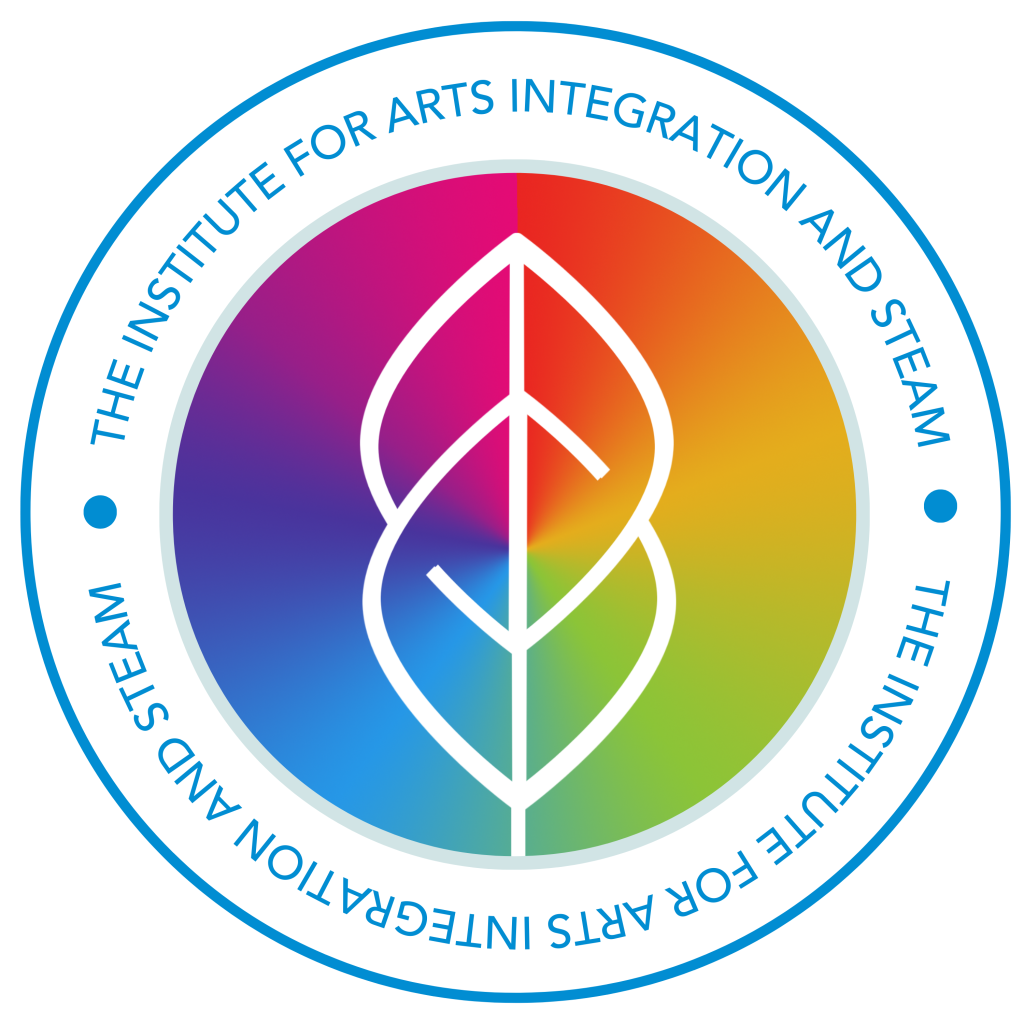ART WORKS FOR TEACHERS PODCAST | EPISODE 135 | 36:46 MIN
Joy as a Teaching Strategy
Enjoy this free download of the Joyful Teaching Resource.
Well, hello Aysha, thank you so much for being with us today.
Aysha
Thank you so much for having me.
Susan
Of course. I always begin by asking our guests to start by telling us their story. Tell us a little bit about yourself and your journey into becoming such a powerful advocate for arts education and social justice.
Aysha
Okay, I'm gonna set an internal clock. I guess I'm a triple Pisces. So there's a lot of big thoughts and feels swimming around at all times. And that's important because I'm also not a linear person. And I think much of my path has been this kind of swirly, spirally, circly thing. So I think, the home base of it is I'm the youngest of four children from Northside St. Louis. And in that environment, I just was born into a world where there was singing, dancing, play. All the kids would hang out over our house. My parents were very involved with one, making sure that we knew as African American children how beautiful we were and our existence was in this country. And so a lot of the games and the play was uplifting black culture and black history. And so in a lot of ways, that's my first school. So that's the foundation. I'm the youngest of four. That means whatever my older siblings do, there's the little mascot. Traipsing along. We're singing, we're playing, we're chanting. There's music. My mom's a singer and dancer, my dad was in activism and arts management and so those that soil is what I sprung forth from and so I don't think I veered from that. think the pathway that my life has taken has again not been linear but it's always come back to that and so I always danced on the side because I didn't grow up seeing professional dancers or understanding what that meant but in college it became quite obsessive I think my hugest thing I like pat myself on the back for is I figured out how to take tap dance three times for credit, you know? And like that counts towards graduation though I was not a dance major, I was an international relations major, so like that is a feat, okay? And I think that speaks to the creativity of an artist is like, well, I have satisfied all my other credits. Let's dance.
And that catapulted me outside of the university setting at American University in Washington, DC into the larger dance community in the DC area and studying international relations with a focus on international youth advocacy. Again, it's like the way I make sense of the world is through play, through dance and performance. So I got all this heady like thoughts and theory and study on international issues of human rights, particularly children's rights. And I had this opportunity to write a book on modern child slavery way back in 2003, and I'm still dancing on the side, air quotes.
And so all of that motion is happening, right? You can kind of see my hands are like dancing and how like these things are happening. And then I go, what if I put them together and said,
I'm just going to try to figure out how to be a full-time artist, but I'm not going to divorce any of that study and any of that curiosity. I'm going to see how I can use my language as a dancer's tap, hip hop, West African storytelling, poetry and movement. How can the stage become the classroom and the text? so that again is from the little girl who grew up playing, laughing, singing, chanting about the beauty of being black and I think learning how to celebrate humanity of people who aren't seen as humans and that's those are the that's the soil those are the seeds and I'm still to this day that singing, chanting, playing black girl who's got all of these heady thoughts over here and it's like but what if we put it on the stage so that's as short of the long of it as I can give you.
Susan
I love this and I love this language that you're using around planting seeds. So you talk about seed planter and being a soil agitator a bit in your work. I would love to know what does that mean to you? Because I am a farmer's kid, right? So speaking of soil agitation and seed planter for me has probably a very different connotation, but maybe not. I'm not sure. So talk about that a little bit more and especially in the context of your work in education and youth advocacy.
Aysha
Yeah, so I love that that resonance is there for you, Susan, because let me tell you, there are plants in my house right now that are just like, I mean, we just won't die, but you're not giving us what we need. So, but I try. I think several, maybe 10, nine or 10 years ago, I was part of Harvard's Project Zero Summer Institute in one of their study group classrooms. And we get time to process the learning that we're doing in these sessions. And I was just like talking through something, the image, I don't know what someone said, but for me, it clicked in that moment of like,
I think my role or the best way to kind of frame how I work in education and as an artist who's never going to bury that is I think I'm like I'm a special type of gardener so I might not be the one who went out and marked the field and measured where the garden bed should go. And I might not be the one who tends to that garden for perpetuity, but I think my role I found as an educator who comes in, I came in as a teaching artist. I came in as the specialist in the school teaching dance, but I wasn't in that environment.
I'm coming into these places to stir some things up, to fertilize some things, to encourage growth, though I might not be there for the long term. I'm not the day in, day out, God bless some teachers who clock in and administrators who clock in Monday through Friday from eight to four. But I think my role is to come in and be a collaborative gardener, if you will. And I think in that study group class, someone heard me spitting through this and they made this image of like this flower. And I was like, yes, I come in and I have a couple extra seeds to plant in the soil. And I think, you know, you know what it is, farmers kid, you gotta, you have to till the soil. Like it needs that agitation. think agitation can be productive. And so I would like to think of myself as an agitational speaker, not a motivational speaker or inspirational, I, or I'm an
agitational person that's come into places with divine, tender, but agitation doesn't always feel good, but that's necessary for growth. so I think that's the best way that I think about my…
And I also think about like kind of I am an auntie. I don't have my own children. I have a fur baby, but I don't have my own human kids. But I know what aunties do and they're supposed to come in and support the learning of that child. They are part of the community. So I think of myself as this soil agitator, as a seed planter, as this creative artistic auntie that gets to come into places and work collaboratively with folks where they are long-term to think about what are some ways we can encourage growth maybe that they can't see because they're there every day and I think that's what my special glasses are for is to come in and go like, have we thought about putting in a little hip-hop here or putting in a little bit more movement here or understanding that rest is also a movement. So that's what that's about. It has not transferred over into my actual plant gardening life, but you know, hey.
Susan
You and me both. You and me both. I have like a beautiful plant that my mother gave me like two years ago that just it will not die but it looks like it wants to. You know what I mean? Like it's just I despite my best efforts. So much to Hershey Grin. I understand. So I love this idea of agitation, of being able to turn things over, having kind of taking a look at them and bringing some air into that and bringing some new life into that, right? So before we get into how like specifically how you do that, let's back up a step. As I'm realizing from our audience perspective, can you just share with them what it is that you do now?
Aysha
you know, listen, I say this, I say this all the time and people either are like, are you playing coy? Are you downplaying? It's the honest truth. I just show up. I show up. I show up and, I, and I might show up with a double Dutch rope is to encourage play and movement. And I might show up and we're creating a playlist. I think, I'm, I'm, I have a healthy, resistance towards formalized titles. Again, because if I'm this person who's on a mission of like divine agitation, I need to stay nimble and not be beholden to, you are a dancer. I am a dancer. I am a choreographer. I just created a new work. I'm still performing and creating work. I am an educator. I teach. Right now, I am showing up as a doctoral student at the University of Texas at Austin, where my research is about particularly looking at the impact of how Black girls play and I'm picking up on work by Dr. Kira Gaunt, but I'm, I know for me that even when I teach hip hop or help people kind of learn about the culture, the history and the dance, I'm centering play. Like the cipher is a way of play, sessioning is a way of play. And so I'm now here at the University of Texas at Austin. Just finished my first year in the doctoral program in performance as public practice. And the previous year I was here as a visiting lecturer and before then I was at Harvard as a lecturer. And again, while that might seem like disparate stars, for me, they are this constellation. And the constellation is play. The constellation is embodiment. The constellation is play and embodiment through hip hop sensibilities. And so when I tell people, people are like, what do you do? It's always to me, I actually kind of.
My breath stopped. I had to fill out my title on this form yesterday. And so I put the title that a friend helped me create for myself way back in undergrad when I was starting to go, I love dance, I love performance, I love thinking about the world. And she's like, you'll be a dancing diplomat one day. If you don't go the Foreign Service route, because I didn't go the Foreign Service route, I was like, I want to be an ambassador, but I don't want to do it that way. She's like, one day you're going put your tab dancing shoes on, and you're going to be this dancing diplomat. And she was so prophetic. And so when my title, when that asked,
It's like, and you can't skip that box, I put the dancing diplomat because dance has been my passport. Diplomacy, if not thinking about it from like the traditional kind of governmental state way, but if diplomacy means how do you help facilitate spaces where people can look at each other and hold space for each other's humanity, then I'm about that type of diplomacy and not about performing title and power. But I really think like if we can cultivate spaces where people feel my three H's more held, heard and humanized then we can actually progress towards truly listening to each other and with each other, embracing our differences, not as obstacles, but as a reality that like, hey, I'm five foot six, you six foot five. We ain't got to fight about that. That's just the truth, you know? And if we extrapolate from that silly example. And so I still am the dancing diplomat. That is my title.
Nobody can take that title from me. That's the other thing about it. Like I call in what I am. Right now the Dancing Diplomat is a doctoral student and she's creating a creative and performing artist and she's an education consultant. So that's… I show up. I think, you know, I show up.
Susan
That's right. Yes. Well, and I think what's beautiful about this is that, mean, Aisha, you embody this whole idea of a holistic person, that we are not just carved into these specific pathways, right, that we've chosen. Yes, I'm an educator, but I'm also a mom and I'm also, you know, a wife and I also am an entrepreneur. And so like I have a mentor who calls it multi-passionate that you are a multi-passionate, whoever you are, right? That, that you bring all of this to the table. And I think it enhances and enriches the conduit that you choose to use, which happens to be through dance. Right. And I want to, I want to go back to what you talked about with using hip hop and play.
Because I think this is hip-hop is such an interesting cultural Expression tool right and so many people get it kind of twisted Sometimes it's often misunderstood especially when we were bringing it into our classrooms and into education, which I hate to see So how do you define hip-hop through play in the context of teaching and what makes it so effective?
Aysha
Yeah, I love that question. It's like mathematically, right, which I'm not a mathematician, so apologies to all those out there. My math goes, I'm a dancer, I count to eight and I start back over, so everything is complicated from there. if we run the math of it and we think about cultural phenomenon that pervade every form, every space of life for everyone, like…
If think about if hip-hop's birthday, which you can't date actually a culture to one day, but the day that is recognized, August 11th, 1973, if we just think about the math of that date, that means the majority, if not all students, K-12 and I would even argue now, undergrad, and beginning grad at least, actually don't know a world that hip-hop hasn't touched. Additionally,
Most educators, principals, administrators, district leadership have not known a world that hasn't been touched by hip hop. Now, do people always understand what the world of hip hop is? No, that's again, the thing that people get twisted. They think it's just what's trending on music platforms and being called rapper hip hop music. That's a part of it, but it's not the whole. They think it's, well there was break dancing, which is actually called breaking at the Olympics. That's hip hop. That's a little slice of it.
So we're talking about a 50 plus year, there's more than 50 plus years, right? But if we use that date, if we use that date as a point of departure, we're talking about over 50 years of documented global phenomenon culture, right? That starts in the New York, that starts in New York, spreads across the states, spreads across the globe. And so I go…
If we are living in a time where there is this powerful, potent, magnetic thing that is touching everyone's lives, why would we go, well, once you get to the doors of the building of the school, you just got to shut the door to that. Like it's literally impossible is what I'm trying to say. And so instead of trying to ignore or minimize or denigrate this thing, why don't we embrace the idea of getting to learn more about it since it is something that actually can put people of different ages, class, gender, race, ethnicity, ability in one space together. It can do that just by its being. Now what we do as the folks who are facilitating those spaces to catalyze on that, that's where we have to go. go, well what is your pedagogical like truth? What is your philosophy about having people in a room and then facilitating learning?
Hip-hop, one, can get people in the room, but it doesn't, it in and of itself won't do the transformative teaching. You have to open yourself up to like now that I have this beautiful thing, now what is it allowing me to think about? How do I maybe?
Make more room to center music as a point of departure to talk about civics, to talk about history, to talk about literacy, to talk about embodiment. And because hip hop was formed not by people doing something very formulaic that was scripted, it was formed by radical imagination. Playing of it, I think, my definition, playing its essence is your willingness to try something over again and just see if you can have fun while you're trying it.
Not winning, not scoring a goal, but if you can have fun through that iterative process, and hip hop is built to meet on that sense of play. DJ Kool Herc had to play with hooking up those those turntables, know, Grandmaster Flash had to play with scratching. The breakers had to play with moves to see, right? The MCs had to play with words, play with rhymes to see what would flow. The DJs had to play with like what kind of music would get people vibing. Like the graffiti artists are playing with techniques, with colors, with blendings, like, and playing with like, can I get up on that big wall? Can I get up on that train? And so if we think about play as the willingness to keep trying something and see you can have fun while you're trying it then that's at the heart of it. And so I offer that as an on-ramp to folks who are like, I heard hip-hop is the spot of all evil. One, it's not. Just definitively, declaratively, I don't know, but evil has existed before 1973. Just gonna put that out there. Okay, do with that what you want. But that's how when I'm approaching educators, and I love every opportunity I get to try to not proselytize, but maybe encourage folks to open up their hearts and their eyes into hip hop, one as a culture, and then therefore you can go, how do I incorporate it? Do I have the capacity to incorporate it? Do I need to do some more learning to understand what hip hop sensibilities and pedagogy is about? Because we don't want to diminish it by just using it as a gimmick to kind of trick people into traditional learning. And so it's here, it's not going anywhere. So how can we just open our hearts and our practices up to what it can help us do to transform our classrooms?
Susan
I think you're so right and it's one of the things we talk about, especially with arts integration a lot, in all art forms is that we don't want to make the arts component be in service of the other objectives that you have, right? It's not an above below thing. It's working in tandem together and honoring the art form.
Just as a teaching and learning moment for our audience, this is one of the things I'm a music teacher by trade often when I'm working with other arts educators or other classroom teachers, to be honest, we start with what are the building blocks of whatever it is that you're whatever arts area you're trying to connect with. So from your perspective, what are some of the building blocks that we should be aware of when it comes to hip hop? If we were going to try to bring this in so that we can honor it as being used in tandem rather than in service.
Aysha
Yeah, this is beautiful. And I just had an opportunity to do some work with music teachers at the American school in Singapore earlier this year. because they're working in early childhood, their music curriculum is like rhythm and how to get their learners to establish rhythm and then different instruments. For me, I came in as the dance element, right? And I'm going, well,
Rhythm is kind of the backbone of dance. Like no offense, but folks, you, well, let's stop dancing off beat in 2025. Holler at your girl. I gave you some private lessons. We gonna get it right. But like, nobody likes music that is like, is the rhythm? What is the times? Where'd it go? What are we doing? Like, you know, even the best jazz break. So the drum solo be going, but it's still under, it's still a back beat, right? So I think about, if I'm going…
There are steps that we're gonna learn. There are techniques. There's history that I'm gonna bring in around the different movements that I'm gonna teach. But if I'm going, first and foremost, my hypothesis is any classroom is supposed to be a space where we help people learn how to hold each other's humanity.
Like you said earlier, dance is my conduit. for me, the level of play and joy. I am exhausted after teaching 30 minutes, 45 minutes, three hours. Doesn't matter because I am like, want, I will work so hard to make sure joy is here because people won't get the fundamentals. They won't get those building blocks if it just feels like it's obligatory. And so I want people to understand rhythm. So we're going to play. I'm going to make understanding rhythm a game. I'm going to do a lot of call and response. That's a hallmark of kind of African aesthetic from that hip hop grows out of, but it also feels like a game to kind of Simon Says, but rhythmically, right? And so what I'm trying to do is build a joy field environment where it is okay to try and it is okay for it to look however it's going to look. Miss Aysha has years. decades on you so I don't want students to try to mimic me I want them to try to find their way to get the thing so if I'm trying to teach different two steps I'm just gonna keep playing with the same rhythm bring in some patterns that are winnable and gamify it, like copy me, one line go, next line go. So the building block for me, honestly, is joy. That's the long answer to that. From joy, we can get to understanding rhythm and groundedness. And one thing that I explored with the teachers in Singapore when we were talking about a style called popping, where the muscles contract and release really hard and fast, is I wanted to reclaim the idea that moving strong, particularly in a woman body, is bad or not cool. And so I made it about strong being fun. Like how hard can we hold our poses? Hold it even harder, hold it even harder, now release. And so again, I want the joy to be there while I'm also going, let's make sure that we're not doing any type of shaming of how our bodies can move different ways. So for me again,
And this stuff comes up, I work with college and graduate students and it is amazing to me the breakup with people's bodies. It happens very early in education because a teacher said you had to all look the same way or.
I would my body was poked at when I was little and so I know that if I don't make it safe and joyous, none of the fundamentals will happen. But if we're talking about technical movement fundamentals, I am thinking about rhythm. For hip hop, I am also thinking about groundedness. Like, why do we stay low? And how can we have fun staying low and staying fluid in our bodies and then freeze? So I'm thinking about those building blocks and why does it look fun to hold a pose strong? You know, hip hop, we're attracted to it because people are, they're putting on their big as bold as attitudes. It's like, want to see your most brave attitude. It's got to translate. So I want to gamify, to joyify these fundamentals of strong body, strong postures, of groundedness and rhythm. From there, we can learn all kinds of steps.
But we can't learn it if the environment is coded to be negative. There's neuroscience behind this, right? I'm thinking Mary Helen and Mordano Yang and Antonio de Blasio. Biologically, if an environment feels threatening, you're not learning because you feel uncared for. Your amygdala just registers the whole place as a threat. now, you know, so the building block for me, Gamify. Joy Gamify, Joy Gamify.
Susan
Nice. And well, and I think that's so true. Again, you go back to the cliche of Maslow before Bloom, but it's true. If we don't have that centering with safety and joy, and I mean, who says this school has to be stripped of the joy? It shouldn't be. It should be the place where it most happens, right? I love that you bring that into your work. One other thing that I noticed about
your work is that you have this kind of centralized piece of radical change, which sounds scary in today's, you know, charged atmosphere sometimes. So I would love to hear more about what does radical change look like for you and in your work and in classrooms and how do we cultivate that?
Aysha
Yeah. You know, so in academia, I'm learning that if you throw the word critical in front of something, then it's like super serious. So I'm like critical recess studies, critical, critical joy pedagogies. So I say that because I think when I was crafting that, that tagline, and I've had that for quite a while is I realized that it's so simple that it's radical to play.
Sometimes, I'm going to tell a little secret to you and anybody who's listening and watching, sometimes I feel like this is bananas to me that I'm getting invited in to help people come back home to play and to back home to joy. That's what's radical is because I think so much in formalized places of learning and in formalized places of work corporate and nonprofit areas that we are we are gently insidiously and effectively coached and coached from a young age that to be taken seriously we there's a literal physical posture there's an appearance there's you know that's enough jokes joy can't be rigorous you know in the arts that's cute what's your real job and I'm like
I think the radical thing I'm trying to do is just get us to come back home where we can breathe. And so I'm like, you know, I'm not gonna lose that line it's been with me like, why would I change my name because people are afraid of my name in this culture? You know what I mean? Like, so I'm like, I'm not gonna change just because like think people have like gotten scared. And it's not even the critical mass of people. It's just a critical mass of folks who have wielded enough decision-making power in unethical ways. But I would hope that it would be less radical to, for instance, a situated classroom in a circle. I am still met with like surprise when whatever space I'm in, and I have a reputation, like people like, we know we gave you the room where like the furniture is movable so you can put people in a circle. I'm like, yes. Like to me, a circle is not radical, but unfortunately it feels radical right now, you know? Like.
Take bringing snacks for three hour classes seems radical to folks. I'm like, if you think there's a reason we give kids.
Graham crackers and applesauce and suddenly we don't need graham crackers and applesauce. I'm sorry, but we need to come back to the basics of snacks and biology. It's frightening to me to be in a space where I have college and graduate students raising their hands to be to ask if they can go to the bathroom. Like you are the CEO of your biology. I'm saying what's radical is essential. If you have to use the restroom, you pay taxes. You should go.
So I wish that it weren't radical. Radical for me is like I'm trying to catalyze coming back home.
Susan
Which is a powerful statement in and of itself that of where we are, where we need to be, where we need to be thinking, what we need to be thinking of. think just it's powerful to know that the things that should be common sense are no longer common, right? That it is radical to suggest something along those lines. But with that said, I also think it's radical to consider that the arts are on the same level as reading and math right now in this country, right? I think even though in our hearts, I mean, we were born to do this as humans. I mean, embracing that is key. Asia, it has been a joy to learn from you today. I could keep going for like another half hour with you. think like I would just love to continue, but.
We're short on time. I would love for you to share with our audience how they can stay connected with you and your important work and possibly bring you into their classrooms as well.
Aysha
Absolutely, yes. And I feel such kindred energy with you, Susan. So thank you again for this time to just kind of kiki and chat.
So, you my parents did something right. They did a lot of things right. But one thing is there's no other Asha Upchurch on the planet. So I'm pretty findable. AshaUpchurch.com. Don't judge the datedness of the website, but if you find it, can get to me. Social media, AshaDances. A-Y-S-H-A-D-A-N-C-E-S.
It is, I do feel like my divine assignment on this planet is to be that auntie, be that gardener.
I get it when folks are tired or feel like they just need a spark to help remember joy, help remember the body, help demystify hip hop. I'm saying put me in coach, I'm that auntie, I was built for this. I have been in every learning environment from K-12 public schools to K-12 private schools, private higher ed, public higher ed,
community centers, carceral spaces, shelters, and it's always the same. Humans want joy and snacks.
Susan
Thank you so much, Aisha. It was a pleasure to be with you today.
Aysha
Thank you so much.

